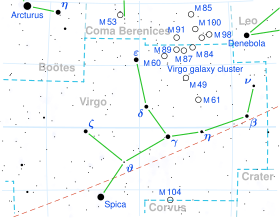Omicron Virginis
| Observation data Epoch J2000.0 Equinox J2000.0 | |
|---|---|
| Constellation | Virgo |
| Right ascension | 12h 05m 12.54049s[1] |
| Declination | +08° 43′ 58.7498″[1] |
| Apparent magnitude (V) | 4.12[2] |
| Characteristics | |
| Evolutionary stage | Red-giant branch[3] |
| Spectral type | G8 IIIa CN-1Ba1CH1[4] |
| Astrometry | |
| Radial velocity (Rv) | −29.62[5] km/s |
| Proper motion (μ) | RA: −225.029 mas/yr[6] Dec.: +33.282 mas/yr[6] |
| Parallax (π) | 19.4936±0.1658 mas[6] |
| Distance | 167 ± 1 ly (51.3 ± 0.4 pc) |
| Absolute magnitude (MV) | +0.52[7] |
| Orbit[8] | |
| Primary | A |
| Companion | B |
| Period (P) | 50.70±3.30 yr |
| Semi-major axis (a) | 21.1±1.7 au |
| Eccentricity (e) | 0.12±0.04 |
| Inclination (i) | 147.8±1.6° |
| Longitude of the node (Ω) | 34±2° |
| Periastron epoch (T) | 2460663±500 |
| Argument of periastron (ω) (secondary) | 180±17° |
| Details[5] | |
| A | |
| Mass | 2.7±0.2[8] M☉ |
| Radius | 11.2±0.3[9] R☉ |
| Luminosity | 57 L☉ |
| Surface gravity (log g) | 3.17 cgs |
| Temperature | 5,107 K |
| Metallicity [Fe/H] | −0.30 dex |
| Rotational velocity (v sin i) | 2.23 km/s |
| Age | 0.88 Gyr |
| B | |
| Mass | 0.94±0.14[8] M☉ |
| Other designations | |
| 9 Virginis, ο Vir, BD+09°2583, FK5 450, GJ 3703, HD 104979, HIP 58948, HR 4608, SAO 119213 | |
| Database references | |
| SIMBAD | data |
Omicron Virginis (ο Vir, ο Virginis) is a binary star in the zodiac constellation of Virgo. It is visible to the naked eye with an apparent visual magnitude of +4.12.[7] Based upon parallax measurements, it is at a distance of 163 light years.
Characteristics
[edit]The components are orbiting around the system's center of mass at a period of 50.7 years, and a nearly circular orbit with eccentricity 0.12 and an average separation of 21 astronomical units.[8]
The primary star is a G-type giant with a stellar classification of G8 IIIa CN-1Ba1CH1.[4] This indicates that it is a Barium star. It is around 11 times larger than the Sun.[9] Although it is slightly cooler, it is radiating about 57 times the luminosity of the Sun. It is over twice as massive as the Sun and is around a billion years old.[5] A simplified statistical analysis suggests that ο Virginis is likely to be a red-giant branch star fusing hydrogen in a shell around an inert helium core, but there is about a 22% chance that it is a horizontal branch star fusing helium in its core.[10]
The secondary is a white dwarf with 94% of the Sun's mass. It contamined the surface of the giant primary with s-process elements when it was on the asymptotic giant branch, causing it to be a Barium star.[8] It may also explain the unexpected SiIV emission flux coming from Omicron Virginis.[11]
References
[edit]- ^ a b van Leeuwen, F. (2007). "Validation of the new Hipparcos reduction". Astronomy and Astrophysics. 474 (2): 653–664. arXiv:0708.1752. Bibcode:2007A&A...474..653V. doi:10.1051/0004-6361:20078357. S2CID 18759600.
- ^ Mallik, Sushma V. (December 1999). "Lithium abundance and mass". Astronomy and Astrophysics. 352: 495–507. Bibcode:1999A&A...352..495M.
- ^ Laney, C. D.; Joner, M. D.; Pietrzyński, G. (2012). "A new Large Magellanic Cloud K-band distance from precision measurements of nearby red clump stars". Monthly Notices of the Royal Astronomical Society. 419 (2): 1637. arXiv:1109.4800. Bibcode:2012MNRAS.419.1637L. doi:10.1111/j.1365-2966.2011.19826.x.
- ^ a b Keenan, Philip C.; McNeil, Raymond C. (1989). "The Perkins catalog of revised MK types for the cooler stars". Astrophysical Journal Supplement Series. 71: 245. Bibcode:1989ApJS...71..245K. doi:10.1086/191373.
- ^ a b c Jofré, E.; Petrucci, R.; Saffe, C.; Saker, L.; de la Villarmois, E. Artur; Chavero, C.; Gómez, M.; Mauas, P. J. D. (2015). "Stellar parameters and chemical abundances of 223 evolved stars with and without planets". Astronomy & Astrophysics. 574: A50. arXiv:1410.6422. Bibcode:2015A&A...574A..50J. doi:10.1051/0004-6361/201424474. S2CID 53666931.
- ^ a b Vallenari, A.; et al. (Gaia collaboration) (2023). "Gaia Data Release 3. Summary of the content and survey properties". Astronomy and Astrophysics. 674: A1. arXiv:2208.00211. Bibcode:2023A&A...674A...1G. doi:10.1051/0004-6361/202243940. S2CID 244398875. Gaia DR3 record for this source at VizieR.
- ^ a b Takeda, Yoichi; et al. (August 2008). "Stellar Parameters and Elemental Abundances of Late-G Giants". Publications of the Astronomical Society of Japan. 60 (4): 781–802. arXiv:0805.2434. Bibcode:2008PASJ...60..781T. doi:10.1093/pasj/60.4.781.
- ^ a b c d e Escorza, A.; De Rosa, R. J. (March 2023). "Barium and related stars, and their white-dwarf companions: III. The masses of the white dwarfs". Astronomy & Astrophysics. 671: A97. arXiv:2301.04232. Bibcode:2023A&A...671A..97E. doi:10.1051/0004-6361/202244782. ISSN 0004-6361.
- ^ a b Baines, Ellyn K.; Clark, James H.; Kingsley, Bradley I.; Schmitt, Henrique R.; Stone, Jordan M. (2025-05-07). "Vintage NPOI: New and Updated Angular Diameters for 145 Stars". The Astronomical Journal. 169 (6): 293. arXiv:2506.02912. doi:10.3847/1538-3881/adc930. ISSN 1538-3881.
- ^ Reffert, Sabine; Bergmann, Christoph; Quirrenbach, Andreas; Trifonov, Trifon; Künstler, Andreas (2015). "Precise radial velocities of giant stars. VII. Occurrence rate of giant extrasolar planets as a function of mass and metallicity". Astronomy & Astrophysics. 574: A116. arXiv:1412.4634. Bibcode:2015A&A...574A.116R. doi:10.1051/0004-6361/201322360. hdl:10722/215277. S2CID 59334290.
- ^ Böhm-Vitense, Erika; Carpenter, Kenneth; Robinson, Richard; Ake, Tom; Brown, Jeffery (2000). "Do All BA II Stars Have White Dwarf Companions?". The Astrophysical Journal. 533 (2): 969. Bibcode:2000ApJ...533..969B. doi:10.1086/308678.

